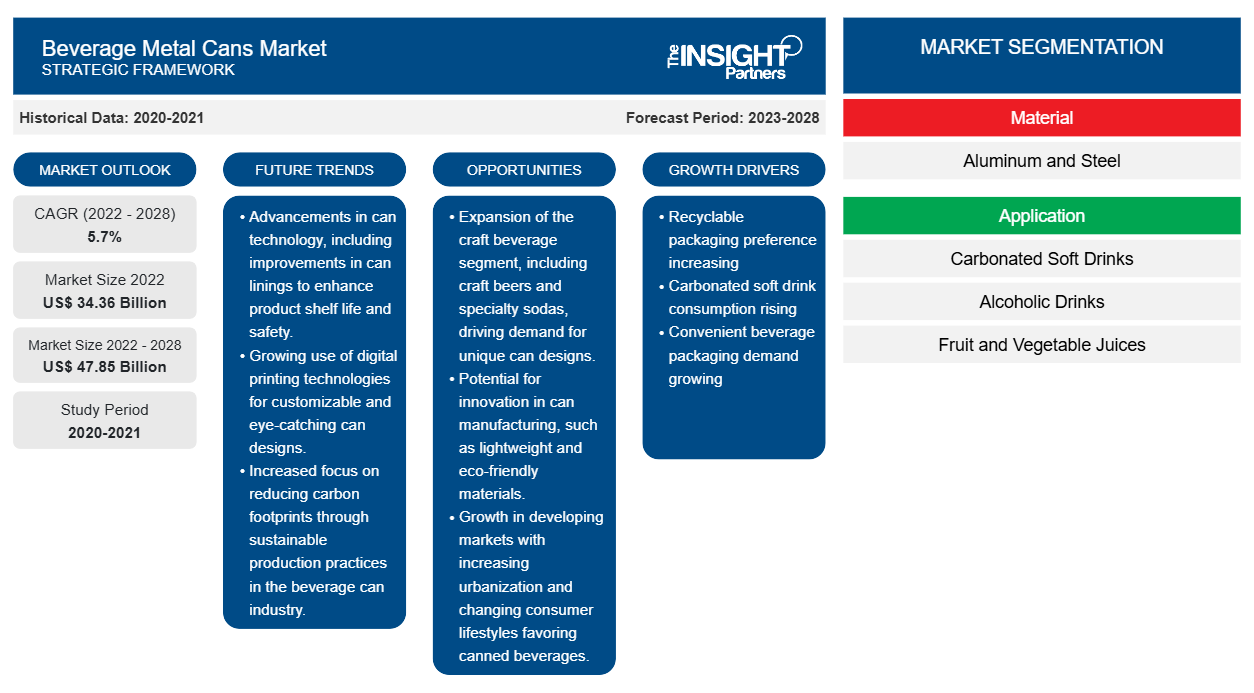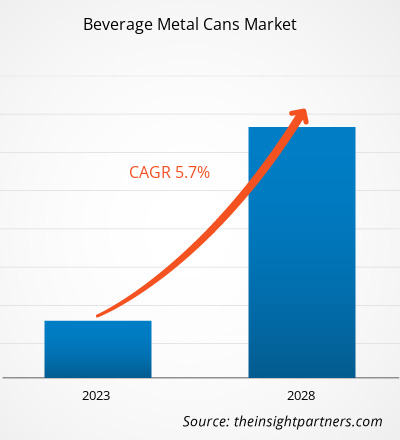预计饮料金属罐市场规模将从 2022 年的 343.6314 亿美元增至 2028 年的 478.5242 亿美元;预计 2022-2028 年复合年增长率为5.7%
市场的增长归因于全球范围内迅速增强的环保意识。因此,政府出台了各种法规,以可回收且环保的金属或玻璃包装替代塑料包装。饮料金属罐的总体碳足迹低于塑料包装,因为其原材料可以从回收材料中获得,而不像塑料那样需要原始原材料。此外,金属包装经久耐用,被认为可安全用于食品和饮料行业。2021年,北美占据全球饮料金属罐市场
的最大份额。然而,预计亚太地区在预测期内的市场复合年增长率最高。亚太市场分为中国、印度、日本、韩国和澳大利亚。韩国、中国和日本等国家是食品和饮料的主要市场。该地区也是众多食品和饮料制造商的所在地,由于国内对包装饮料的需求增加,这些制造商的数量正在增长。预测期内,亚太地区饮料产量的增加以及对可回收包装材料的日益青睐将有助于该地区市场的增长。
您可以免费定制任何报告,包括本报告的部分内容、国家级分析、Excel 数据包,以及为初创企业和大学提供优惠和折扣
饮料金属罐市场:战略洞察

-
获取此报告的顶级关键市场趋势。此免费样品将包括数据分析,从市场趋势到估计和预测。
COVID-19疫情对饮料金属罐市场的影响
由于不同地区的长期封锁,制造单位停工,旅行、国际贸易和供应链的限制以及原材料供应短缺,COVID-19 疫情严重扰乱了制造业的运营效率。由于制造单位停工、原材料价格上涨、劳动力短缺、供应链中断和金融不稳定,疫情对市场产生了负面影响。此外,由于 COVID-19 疫情导致的经济放缓,食品和饮料行业也受到干扰,阻碍了市场的增长。然而,随着各国逐步放松先前实施的限制措施,企业正在蓬勃发展。此外,各国政府推出的 COVID-19 疫苗进一步缓解了疫情,导致全球商业活动增加。此外,各国政府正在计划开发现代化和技术先进的基础设施,以减轻疫情对经济的影响。在封锁期间,消费者购买了大量包装食品和饮料,而不是食品服务产品。因此,尽管受到 COVID-19 疫情的负面影响,但预计未来几年饮料金属罐市场仍将实现显著增长。
市场洞察
碳酸软饮料消费量高
碳酸软饮料是根据消费者的口味和风味偏好而制作的,最近这些产品被开发出来作为注重健康的消费者的功能性饮料。 由于制造商不断推出新口味,碳酸软饮料在消费者中越来越受欢迎。对清洁标签、无麸质、低卡路里和低碳水化合物产品的需求不断增长,也增加了对碳酸软饮料的需求。金属罐被广泛用作碳酸软饮料的包装材料。
消费者期望新推出的软饮料不含长期有害健康的成分,并通过精心挑选的成分来促进身心健康。预计低糖软饮料和具有缓解压力功效的产品将继续受到消费者的欢迎。随着功能性饮料行业的扩张和消费者健康意识的增强,健康饮料的趋势越来越受欢迎。沃尔玛和便利店等市场上低卡路里或零卡路里饮料的普及推动了碳酸软饮料的消费。因此,碳酸软饮料需求和消费的增长推动了金属罐饮料市场的增长。
应用程序洞察
根据应用,全球饮料金属罐市场细分为碳酸软饮料、酒精饮料、果蔬汁和其他饮料。2021年,酒精饮料占据了最大的市场份额。酒精饮料由浆果、水果、谷物以及植物汁液、块茎、蜂蜜和牛奶等其他成分中的糖分发酵而成。它们可以通过蒸馏将原来的水状液体转化为酒精度数更高的液体。此外,对便携式容器的需求增长推动了酒精饮料市场的增长。由于全球消费者工作习惯的改变,罐装酒精饮料市场可能会增长。罐装有助于保持饮料中的纤维含量,在不影响质量的情况下延长保质期,使其成为生产具有软功能优势的饮料制造商的首选。
Ball Corporation、Crown Holdings, Inc.、Ardagh Group SA、CANPACK、Orora Packaging Australia Pty Ltd、Amcor plc、Silgan Containers LLC、ZI Industries Limited、SHOWA DENKO KK 和 Envases Group 等公司 都是金属饮料罐市场的参与者。这些公司为市场提供广泛的产品组合。这些公司在发展中地区都有业务,这为金属饮料罐市场的增长提供了丰厚的利润。市场参与者正在开发高质量和创新的产品,以满足客户的需求。
饮料金属罐市场区域洞察
Insight Partners 的分析师已详尽阐述了预测期内影响饮料金属罐市场的区域趋势和因素。本节还讨论了北美、欧洲、亚太地区、中东和非洲以及南美和中美洲的饮料金属罐市场细分和地域分布。
饮料金属罐市场报告范围
| 报告属性 | 细节 |
|---|---|
| 2022年的市场规模 | 343.6亿美元 |
| 2028 年市场规模 | 478.5亿美元 |
| 全球复合年增长率(2022-2028) | 5.7% |
| 史料 | 2020-2021 |
| 预测期 | 2023-2028 |
| 涵盖的领域 |
按材质
|
| 覆盖地区和国家 |
北美
|
| 市场领导者和主要公司简介 |
|
饮料金属罐市场参与者密度:了解其对业务动态的影响
饮料金属罐市场正在快速增长,这得益于终端用户需求的不断增长,而这些需求的驱动因素包括消费者偏好的演变、技术进步以及对产品优势的认知度的提升。随着需求的增长,企业正在拓展产品线,不断创新以满足消费者需求,并抓住新兴趋势,从而进一步推动市场增长。

- 获取饮料金属罐市场主要参与者概览
报告聚焦
- 饮料金属罐市场的进步行业趋势有助于参与者制定有效的长期战略
- 发达市场和发展中市场采用的业务增长战略
- 2019年至2028年饮料金属罐市场定量分析
- 全球饮料金属罐需求量估算
- 波特的五力分析说明了行业中买家和供应商的效力
- 了解竞争市场形势的最新发展
- 市场趋势和前景以及推动和抑制饮料金属罐市场增长的因素
- 通过强调支撑商业利益的市场策略来协助决策过程,从而促进市场增长
- 饮料金属罐市场规模在各个节点的规模
- 市场详细概述和细分,以及饮料金属罐行业动态
- 各地区饮料金属罐市场规模及增长潜力
《2028年全球饮料金属罐市场分析》是一项针对化学品和材料行业的专业深入研究,尤其关注全球饮料金属罐市场趋势分析。该报告旨在提供市场概览和详细的市场细分。饮料金属罐市场根据材料、应用和地域进行细分。按材料,市场分为铝和钢。按应用,饮料金属罐市场分为碳酸软饮料、酒精饮料、果蔬汁和其他。按地域,市场大致分为北美、欧洲、亚太地区 (APAC)、中东和非洲 (MEA) 以及南美和中美。
公司简介
- 鲍尔公司
- 皇冠控股公司
- 阿达集团
- 加拿大包装
- Orora 包装澳大利亚有限公司
- 安姆科公司
- 西尔根集装箱有限公司
- ZI实业有限公司
- 昭和电工株式会社
- Envases集团
- 历史分析(2 年)、基准年、预测(7 年)及复合年增长率
- PEST和SWOT分析
- 市场规模、价值/数量 - 全球、区域、国家
- 行业和竞争格局
- Excel 数据集
近期报告
相关报告
客户评价
购买理由
- 明智的决策
- 了解市场动态
- 竞争分析
- 客户洞察
- 市场预测
- 风险规避
- 战略规划
- 投资论证
- 识别新兴市场
- 优化营销策略
- 提升运营效率
- 顺应监管趋势






















 获取免费样品 - 饮料金属罐市场
获取免费样品 - 饮料金属罐市场